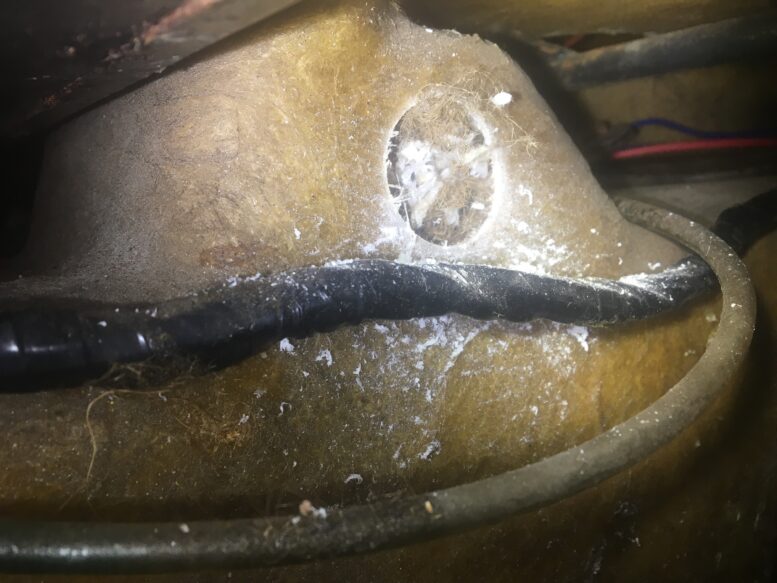I finally heard from Bring a Trailer (BaT) regarding the listing of “the Baby,” the original-owner ’72 2002tii that was owned by my friend Chris’ husband until his death last year. They have assigned us an auction specialist, so I expect that any day now, I’ll engage in the back-and-forth required to craft a listing that both reads in BaT’s house voice as well as conveying some level of useful information. So maybe in a week or two we’ll have an actual auction.
Last week I wrote about the near-debacle with my Lotus Europa’s paint being nearly destroyed by my covering the car for a few days in rain and high heat. After laying the Lotus up for several months, I’ve been working quite a bit on it, since I’ve been entertaining the possibility of driving it to the Lotus Owners Gathering (LOG) 2022 event in West Virginia.
This has appeal for a few reasons. To date, the farthest I’ve driven the car is western Massachusetts. That was just an afternoon tryst; I feel that our relationship needs to be consummated—er, I mean cemented—with a real road trip. The LOG event location, Canaan Valley State Park, is about 600 miles from me and fairly close to the route that I’ve run a dozen times heading down to the Vintage. That’s doable in one day in a normal car.
Of course, the Europa isn’t a normal car; it’s a tiny fiberglass-bodied little-bit-of-a-thing that could be taken out by a pothole, a pavement change, or a particularly buff squirrel, so maybe two 300-mile days is more realistic. And the thought of driving a 42-inch-high 1,600-pound fiberglass-bodied vehicle next to all the tractor-trailers that saturate I-78 and I-81 isn’t exactly a relaxing one.
One of the longstanding issues with the Lotus has been the persistent smell of mice. Fortunately, it’s never been at the gag-me level, as it was with the mouse-infested truck; it’s been more of a darkness hiding in the wings, the boogie-man-under-the-bed kind of thing. But it’s something that I’d like to, if not eliminate, at least mitigate before committing to pounding out big mileage in the car.
Among the things I’ve learned in my decades of dealing with rodent contamination is that any vehicle that sits in anything other than a sterile indoor environment with cats patrolling the aisles is almost certain to have some level of rodent intrusion; whether or not it’s problematic depends heavily on what it is and where it is. There’s an enormous difference between stashed acorns in some inert cavity versus a poop-and-pee-where-you-live nest in the heater box through which all of the car’s ventilation flows.
And then there’s the case of a decaying mouse carcass anywhere.
I recently helped someone have a look at a 2002tii. When I pulled up the rear seat to inspect the subframe attachment points for rust, I was stunned to find nearly the entire sub-seat cavity filled with a mouse nest. Once it was exposed, the smell nearly bowled us over, but I had no prior inkling that it was there.
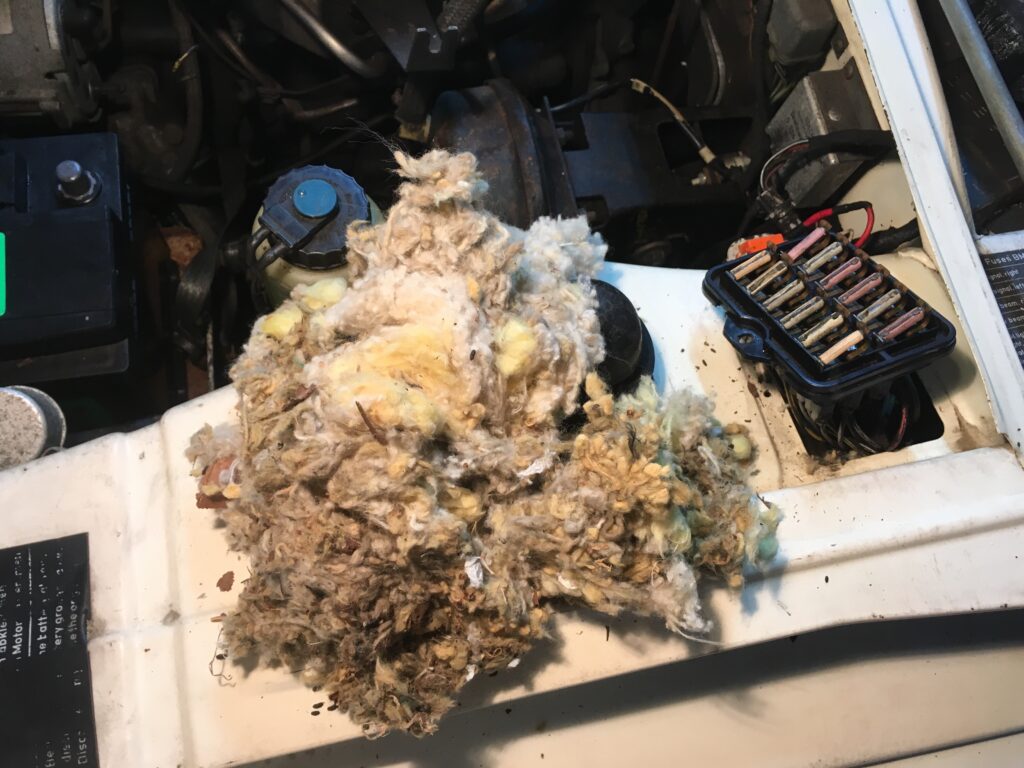
This long-stored 2002 was, as they say, packing, but the nest’s presence was nearly nose-invisible.
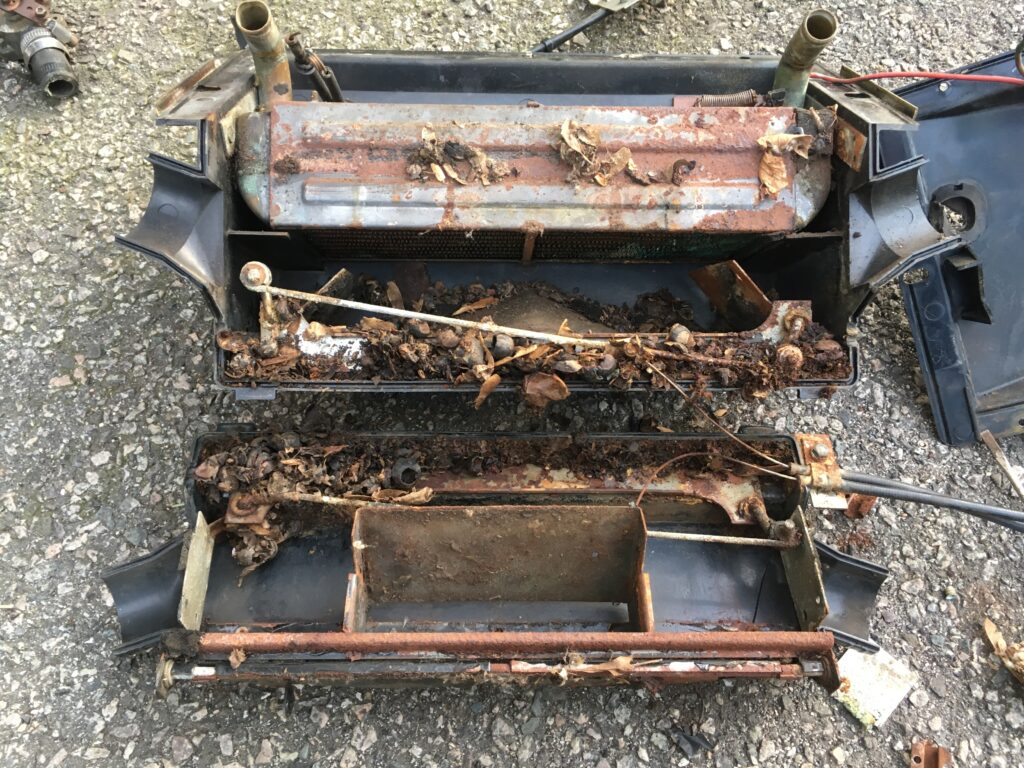
Even this nest in my tii’s heater box wasn’t really all that smelly, as it appeared to be mostly stashed food.
There’s a common-sense procedure to treat mouse contamination:
- Locate the source of the contamination and remove it. Until you do this, you are, as they say, just pissing in the wind. No level of deodorant is going to be effective until the source of the smell–the poop, the nest, or the dead body–is gone.
- Vacuum and rinse the affected area as thoroughly as possible. If it’s porous, like a rug or headliner, and mouse waste is soaked into it, it’s probably best to replace it.
- Treat the affected area with an enzyme-based cleaner that will chemically neutralize the smell. I was very pleased with the performance of Rocco & Roxie, but I imagine that any enzyme-based cleaner specifically formulated for pet messes is similar. Allow it to soak in, then wipe or rinse thoroughly.
- Run an ozone generator to help kill the smell that has soaked into soft surfaces that had no direct contact.
This past winter, thinking forward to the LOG event in West Virginia, I began a fairly concerted effort to de-mouse the Lotus. I snaked my $30 iPhone inspection camera into the heater box, and although I didn’t see any evidence of mouse habitation there, I decided that the smell was strong enough when I had the heat on that I should just pull the box.
On paper, it’s not really any more difficult than removing the heater box on a 2002, but one of the hoses plumbing the box runs right behind the fuse box, and the idea of disturbing what is a well-functioning Lucas electrical system gave me pause. Plus, the Europa is a tiny little car, and certain things need to be done by lying on your back with your head up under the dashboard; it’s bloody uncomfortable. So when I found actual visible mouse contamination beneath the console and under a few of the rug pieces, I went for the low-hanging fruit and abandoned the idea of pulling the heater box that had no visible evidence of contamination.
Unfortunately, each time I found concentrated contamination, removed and cleaned it, and felt that this could be it, after a few days of sitting, the smell returned.

The arrow points to a heater hose. Are you going to disturb those British electrons if you don’t really need to?
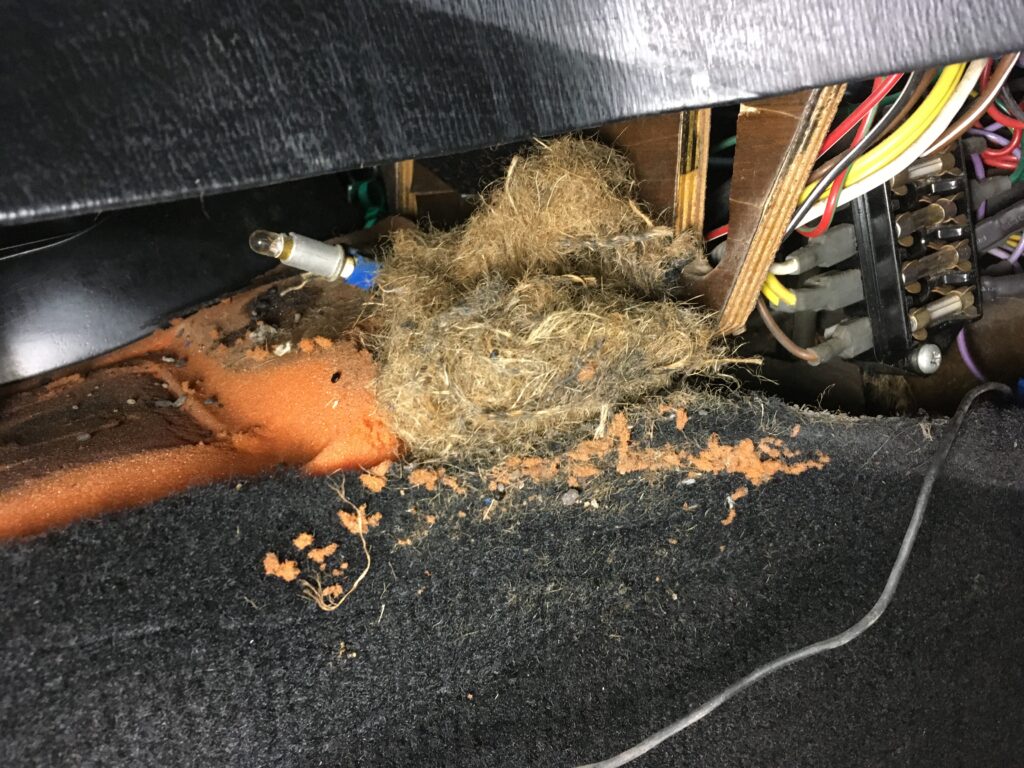
Unfortunately, this wasn’t it.
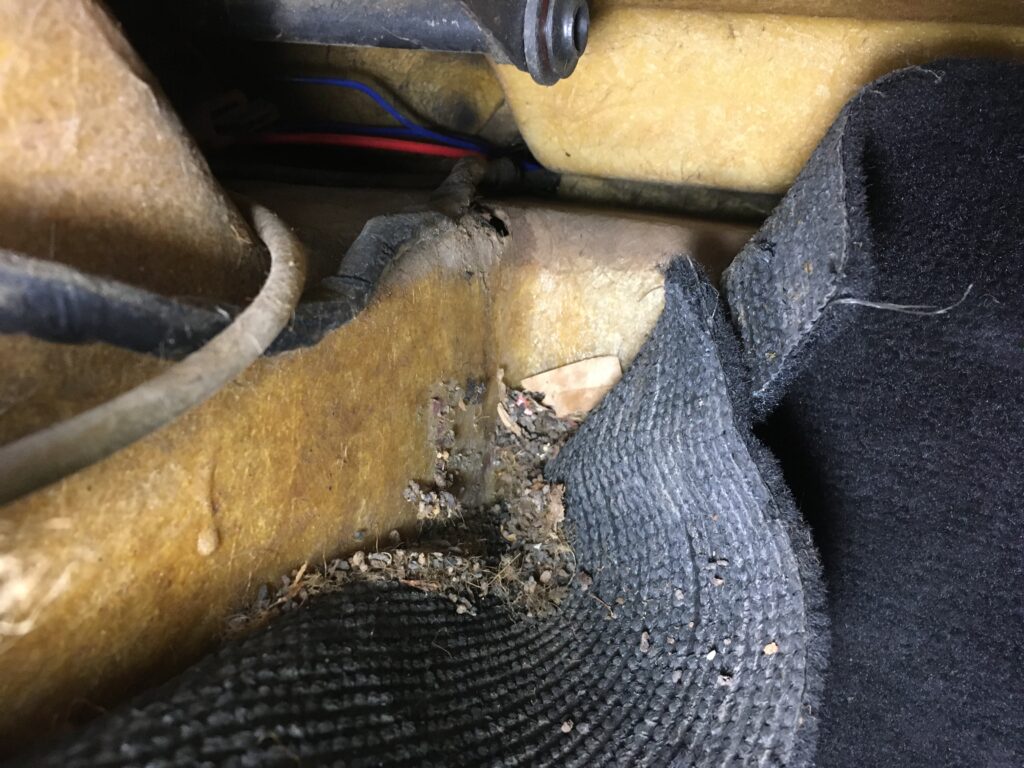
Nor was this.
I had assumed that the mother lode was likely in the forward cavity of the Europa’s fiberglass body. This is a mid-engine car, so when you open the hood, that’s the front trunk (or “frunk,” as Europa folks sometimes refer to it), and it has a non-intuitive delineation between outside (what’s exposed to weather) and inside (what’s connected to the interior of the car). Air flows through the grille into the frunk, and from there, into both the fresh-air vents (which I’d long ago cleaned) as well as the heater box. But in addition, there’s a big rubber plug, which, when removed, allows access to the handbrake linkage.
This is a funny area because it seems like it’s outside, but it’s not: If you stick your head up under the footwells and look forward, you can actually see these linkage components from inside the car. Thus, any mouse deposits in this area are certainly going to smell up the interior of the car, even if they’re not in the direct ventilation path of the vents or heater box.
Unfortunately, because this area is part of the cabin and not part of the frunk, you can’t simply flood it with water to wash everything out, because there’s no path for the water to run anywhere other than onto the rug. I blew it out with compressed air, vacuumed up the small amount of mouse droppings that ricocheted into the car, and sprayed enzyme cleaner into it, but it didn’t make much of a difference.
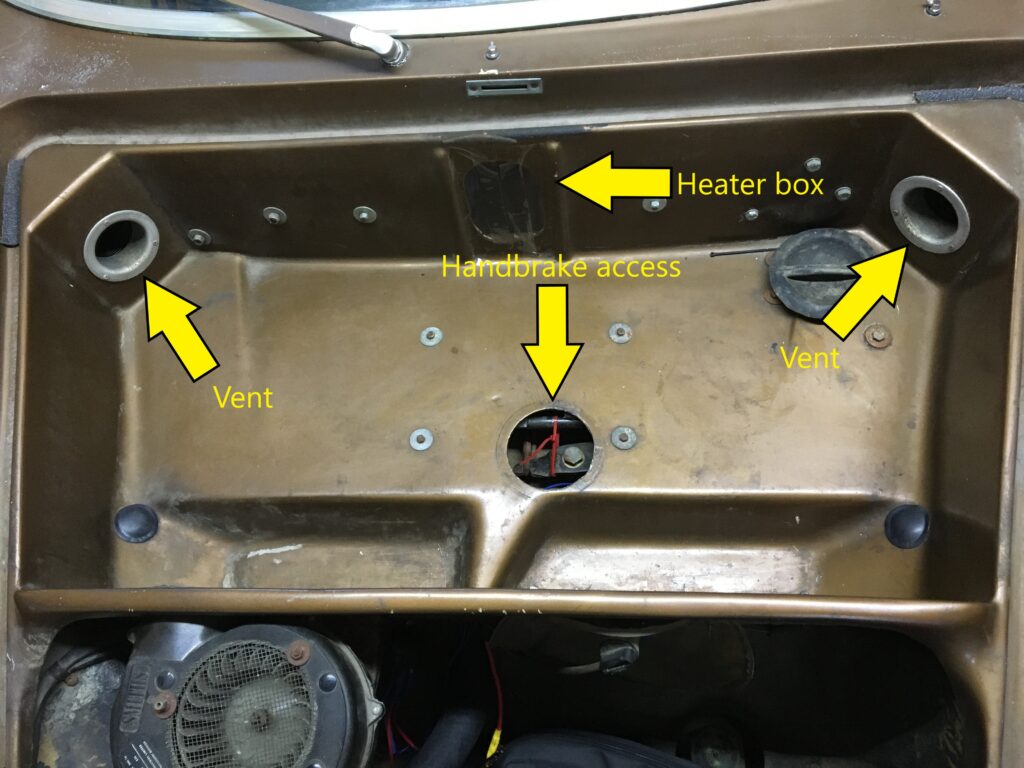
The Lotus’ “frunk” shows the openings for the fresh-air vents and the heater box, and the odd handbrake access hole that’s normally hidden by a rubber plug.
Then I did something that I should’ve done earlier: I read up on mouse contamination on one of the Europa forums. I learned that there was another major factor I was ignoring: the frame.
The Europa has a Y-shaped frame with a boxed front section that sort of looks like a hammerhead shark, to which the front steering and suspension components are attached. The entire frame is hollow, so it shouldn’t have surprised me to learn that rodent nesting can occur at any point in the frame. However, the frame is clearly outside the car, so initially I was dismissive of the idea that the smell from mouse contamination in it could permeate through to the passenger compartment in a significant way.
But then I realized that the steering column and brake master cylinder both go through the front box, and that the shift linkage and the handbrake cable run down the center section, so there are in fact multiple vectors for smells to get inside.
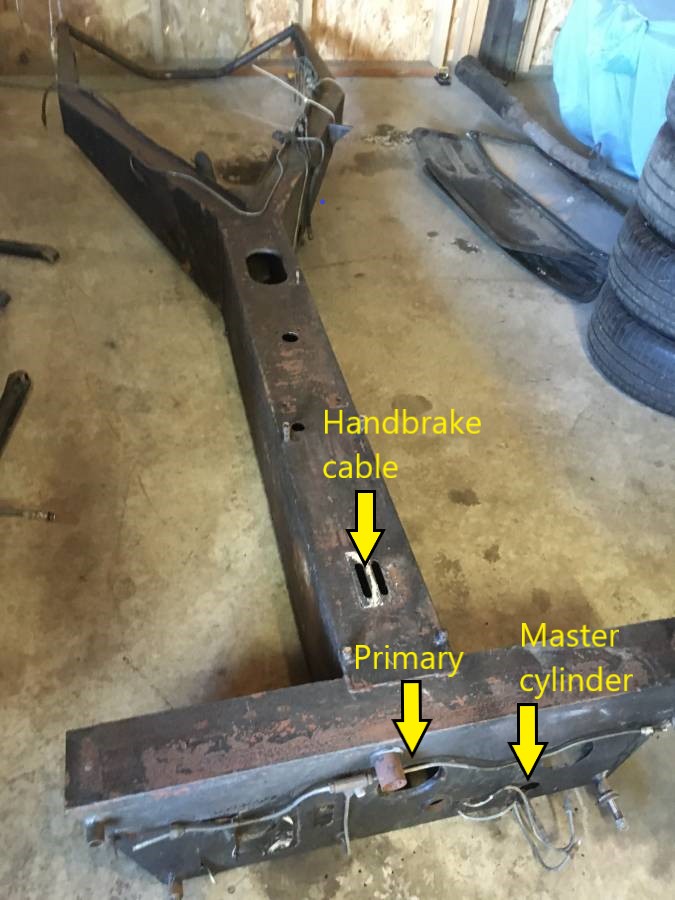
The frame of a Europa (someone else’s, not mine) shows the primary hole that’s usually covered by the rubber plug, the opening for the master cylinder, and the slots on the top where the handbrake cable goes through.
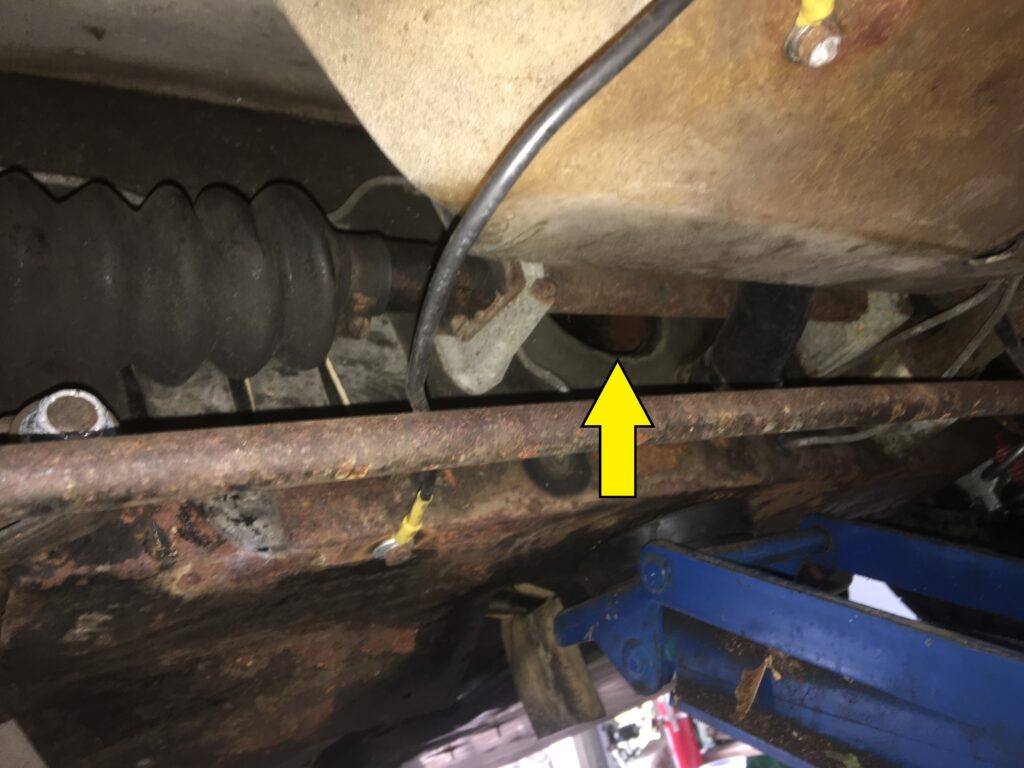
The boxed front section on my car shows how the steering rack occludes access to the primary hole. The hole itself is certainly big enough to reach into, but there’s not really enough clearance to get your arm in and reach from side to side.
Like the frunk, the boxed front section has a large rubber plug that covers an inspection hole (labeled “primary” above). I pulled off the rubber plug, stuck a gloved hand inside, and immediately began to pull out handfuls of mouse detritus. I chased it to the right, but wasn’t able to get my arm in there due to clearance issues. Fortunately, I found that there was another hole, covered by tape, for what I assume is the master-cylinder location on right-drive cars; using long-handled tweezers, I pulled out a Kleenex-box-size mouse nest.

Whoa.
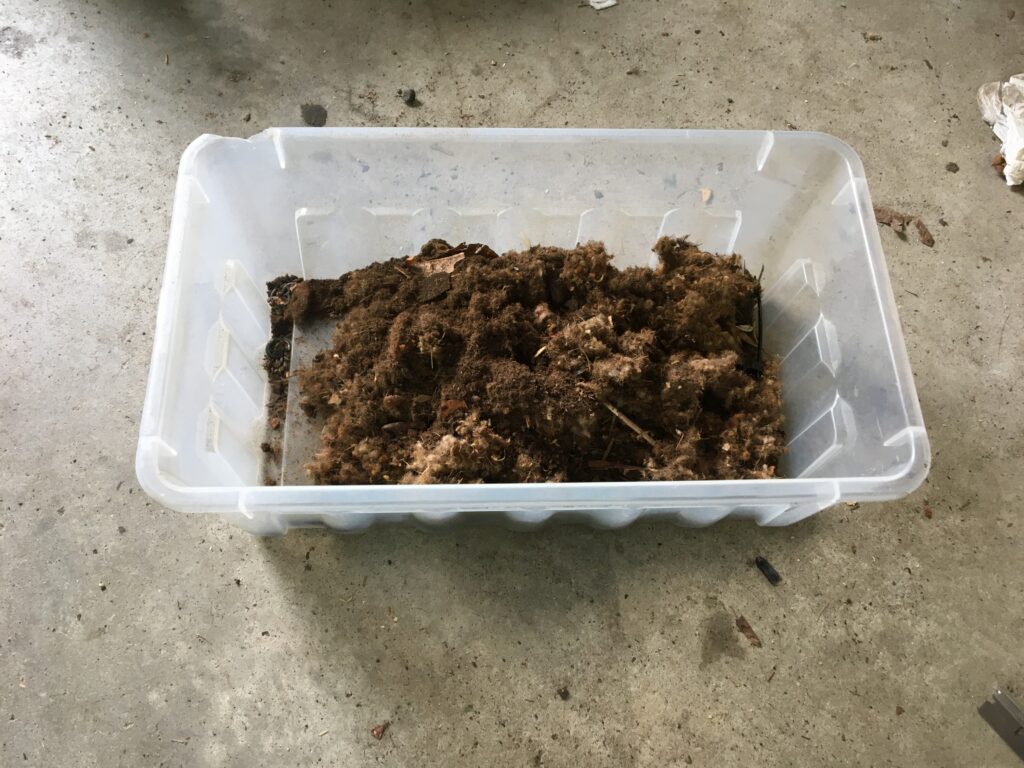
Yeah, I know: ick. But finding and removing nests like this is a good thing.
I was about to do the same kind of full-on decontamination that I did on the heater box of the mouse-infested truck (rinsing with water followed by soaking with enzyme-based cleaner, repeat repeat) when I realized that drainage might be a problem. The truck’s heater box had the advantage that I could rinse it in place, because the heater box also houses the a/c condenser, and thus has a drain at its lowest point for the condensation that naturally forms inside it.
The Europa’s front box, however, has no such drain at its lowest point, and I was hesitant to take an area that had been dry for decades (mouse-contaminated, but dry) and get it wet in a way that could not easily be drained and dried. So instead I duct-taped a flexible hose to my shop vac, snaked it in, sucked out everything that I could, verified with the inspection camera that I’d at least gotten the mother lode of nesting material, although certainly not every single dropping, and stopped before I did more harm than good with water.
While I was under the car, I looked upward through the primary hole and realized that I could see the two slots where the handbrake cables go through. I also realized that I was seeing what appeared to be more nesting material. Unfortunately, there was no way to reach it. However, I figured out where this area was inside the car; it was in front of the console under a bulge in the fiberglass body. As I did last year with the heater box in the truck, I drilled a small inspection hole, snaked in the inspection camera, verified that this was where the nest was, then drilled a 1-1/4″ hole with a hole saw and again probed with the long tweezers.

Gotcha. Again.
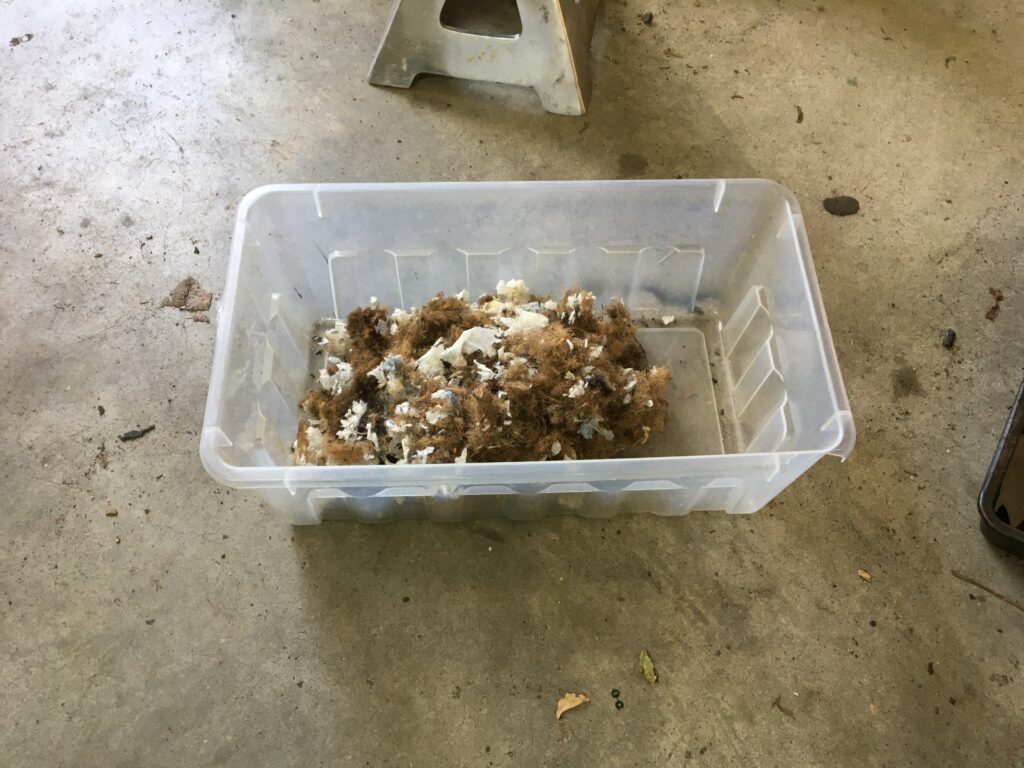
But wait! There’s more!
Unfortunately, after removing the bulk of the nest, when I snaked in the inspection camera, I found that when I looked backward on the top of the frame, I could see that the narrow section between the frame and the fiberglass body is packed with nesting material. There’s no way to get it out unless I want to lift the body off or use the hole saw and drill holes all the way along the length of the body. So a full-court press on the contamination will need to wait until the fiberglass body gets pulled off the frame, which will likely be never.
As with the front box, I vacuumed the area out as best as I could, put a rubber plug in the hole that I’d drilled, and stopped. The next day I drove the car, including a stint with the windows up and the fresh-air vents open, since I’d need to do that if it began raining on a road trip. I wouldn’t be so rash as to call the problem solved, but I think that it is a step-change better.
Unfortunately, a few days after that, while Maire Anne and I were on a mini-vacation in our little RV on the Cape, I somehow managed to anger-up my fifteen-year-old back injury, so right now getting in and out of the Lotus, much less taking a 1,200-mile drive in it, is out of the question.
Among the many things I am thankful for with vintage BMWs is that unlike the Lotus, there’s not a hollow frame that runs the length of the car and provides a subterranean rodent interstate highway.
Of course, there is that area under the back seat.—Rob Siegel
Rob’s new book, The Best of The Hack Mechanic, is available here on Amazon, as are his seven other books. Signed copies can be ordered directly from Rob here.

